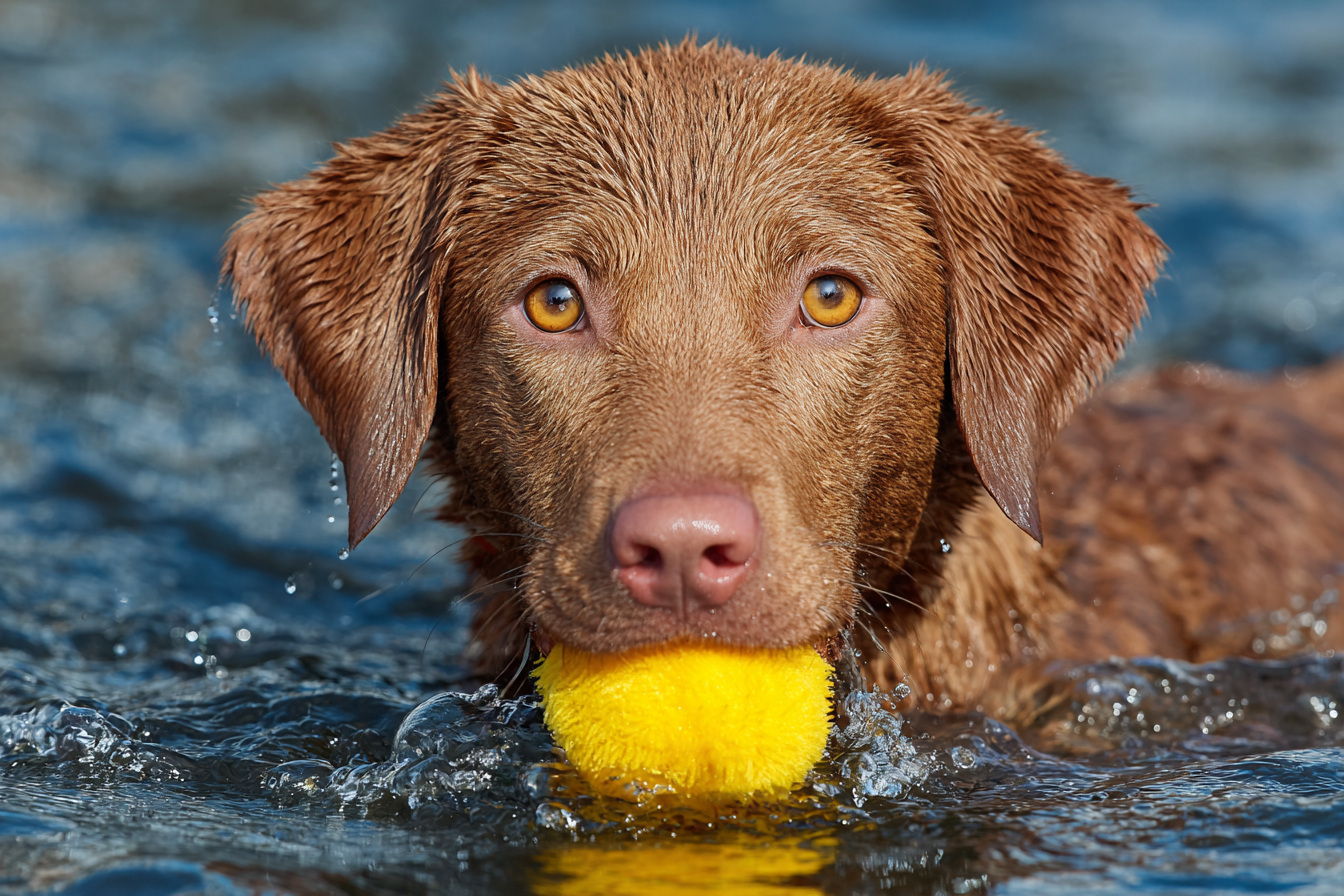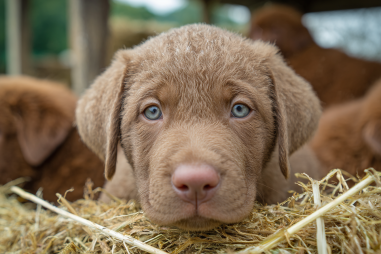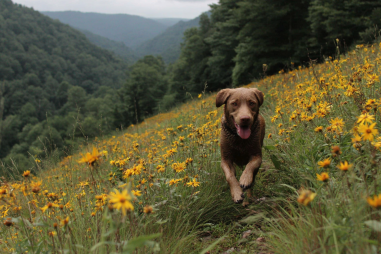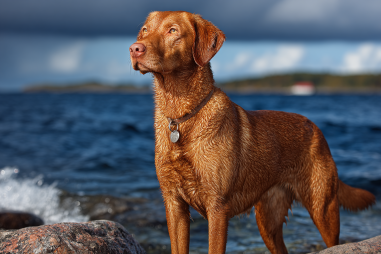Chesapeake Bay Retrievers are known for their remarkable swimming abilities and strong retrieving instincts. These traits make them excellent companions for water-based activities, whether it’s casual swimming, hunting, or participating in water sports. Training your Chesapeake Bay Retriever for water activities not only enhances their natural talents but also ensures they stay safe and have fun. This guide will walk you through effective and safe water training techniques to help your furry friend become a confident and skilled water dog.
Natural Affinity for Water
The Chesapeake Bay Retriever, affectionately known as the “Chesapeake” or “Chessie,” has a rich history as a waterfowl retriever in the challenging conditions of the Chesapeake Bay area. Their dense, waterproof coat and powerful build enable them to tolerate cold water and rough currents with ease. Unlike many other breeds, Chessies possess an innate love for water, making them eager and enthusiastic swimmers from an early age.
Because of this natural affinity, introducing them to water often requires less encouragement compared to other breeds. However, a structured approach to training helps harness their enthusiasm productively and safely, especially when teaching them specific retrieving commands and ensuring their safety around water bodies.
Safety Precautions and Initial Introduction
Before diving into water training, safety should be the foremost concern. Even natural swimmers can encounter hazards such as strong currents, cold temperatures, or unfamiliar water environments. Here are some essential safety precautions to consider:
- Choose a safe training location: Start in calm, shallow water like a quiet pond or a swimming pool designed for dogs. Avoid areas with strong currents, steep drop-offs, or heavy boat traffic.
- Use a dog life jacket: Especially during initial introductions, this provides extra buoyancy and keeps your dog visible. It can be a lifesaver in emergencies and boosts your dog’s confidence.
- Check water temperature: Avoid very cold water to prevent hypothermia. In cold climates or seasons, keep swimming sessions brief or use protective gear if necessary.
- Supervise constantly: Never leave your dog unattended around water, even if they are confident swimmers.
- Rinse after swimming: Saltwater, chlorine, and algae can irritate your Chesapeake’s skin and coat. Always rinse them with fresh water after each session.
When introducing your Chesapeake Bay Retriever to water for the first time, be patient and positive. Use toys and treats to create a welcoming environment and avoid forcing your dog into the water, which can cause fear or reluctance.
Step-by-Step Water Training Exercises
Progressive training helps build your dog’s confidence and skills gradually. Here’s a step-by-step plan to get your Chesapeake Bay Retriever comfortable and skilled in the water:
1. Familiarization with Shallow Water
Start by encouraging your dog to wade in shallow water. Toss toys or treats just beyond the water’s edge and praise your dog for any steps taken into the water. Keep sessions short and fun.
2. Encouraging Swimming
Once your dog is comfortable wading, encourage them to swim short distances. Use a floating toy to entice them to retrieve items in slightly deeper water, always ensuring that they can touch bottom initially.
3. Building Endurance
Gradually increase the swimming distance and duration. Monitor your dog’s energy levels and offer rest breaks. Swimming is a great exercise but can be taxing if overdone.
4. Introducing the Use of a Life Jacket
If not already used, introduce the life jacket to familiar water sessions to get your dog comfortable wearing it. Life jackets are especially useful when transitioning to deeper or open water settings.
Retrieval Commands and Drills
Chesapeake Bay Retrievers excel in retrieving, but clear commands and consistent practice are crucial to success. Teaching specific retrieval commands helps your dog understand what is expected during hunting or play.
Basic Retrieval Commands
- “Fetch”: Standard command to encourage your dog to retrieve an object.
- “Bring it here” or “Come”: Commands to have your dog return with the retrieved item.
- “Drop it” or “Release”: To teach the dog to release the object cleanly on command.
Training Drills
Consistent practice enhances obedience and enthusiasm for retrieving in water:
- Shallow Water Toss: Throw toys into shallow water for your dog to fetch and return.
- Mark and Retrieve: Toss the toy into deeper water, encouraging your dog to mark where it lands and swim out to retrieve it.
- Blind Retrieve: Hide the toy just out of sight and use verbal commands to direct your dog to find and fetch it, boosting their scenting and problem-solving skills.
Using positive reinforcement such as treats, praise, and petting encourages your dog to enjoy and excel in retrieval tasks.
Advanced Water Sports and Activities
Once your Chesapeake Bay Retriever is proficient in basic water training, you can explore more advanced water activities that challenge both their physical and mental abilities:
- Dock Diving: This exciting sport involves your dog running and jumping off a dock into water to retrieve toys for distance or height.
- Water Rescue Training: Chessies’ natural swimming skills make them excellent candidates for water rescue roles, which can be trained with professional guidance.
- Water Retriever Competitions: Participate in trials that assess skills like blind retrieves, marking, and obedience in water environments.
- Kayaking or Paddleboarding Companions: Teach your dog to safely ride alongside or on watercraft, enhancing their water experience.
These activities not only provide great exercise but deepen the bond you share with your Chesapeake Bay Retriever, making training a rewarding adventure for both of you.
Maintaining Health with Water Training
Water training is excellent exercise but requires proper care to keep your Chesapeake healthy and happy:
- Regular Coat Care: After swimming, rinse your dog thoroughly to remove salt, chlorine, or debris. Dry their ears thoroughly to prevent infections, as Chessies have floppy ears that trap moisture.
- Hydration and Rest: Ensure your dog has access to fresh drinking water and rest periods, especially after intense swimming sessions.
- Monitor for Fatigue or Injury: Keep an eye out for signs of overexertion, muscle strains, or cuts from underwater hazards.
- Annual Veterinary Checks: Keep up with regular health checkups and vaccinations to maintain overall well-being.
By combining fun water activities with attentive care, you support your Chesapeake’s long-term health and enjoyment of water training.
Making Water Training a Lifelong Enjoyment
Training your Chesapeake Bay Retriever for water activities unlocks their natural talents and provides countless hours of active fun for both pet and owner. With patience, positive reinforcement, and a focus on safety, your Chessie will develop into a confident, skilled swimmer and retriever. Whether you enjoy casual swimming, participate in competitive water events, or engage in hunting excursions, a well-trained Chesapeake Bay Retriever is a joy to have by your side.
Remember, the key to successful water training is consistency and building positive memories around water experiences. Your Chesapeake will thank you with enthusiasm, loyalty, and those unmistakable joyful splashes that make every training session worthwhile.







